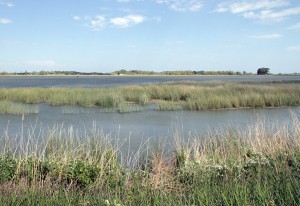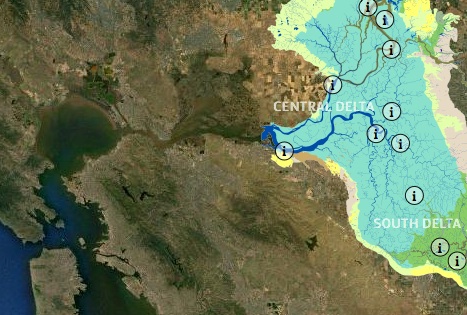Battle lines are forming as Governor Brown prepares to roll out his proposal for the Delta

On Wednesday, Governor Jerry Brown and Interior Secretary Ken Salazar are expected to announce a multi-billion dollar plan designed to fix California’s longstanding water war in the Sacramento-San Joaquin Delta.
Their proposal for a 35-mile water tunnel is set to reignite the fight over how water is exported from the Delta. The announcement comes just months after federal and state wildlife agencies warned that the proposed version of the project could have dramatic impacts on Delta fish.
Political wrangling over the governor’s announcement has already begun. Two weeks ago, 11 members of Congress [PDF] urged officials to release more details about the costs and benefits of the plan before moving ahead. Senators Feinstein and Boxer sent a letter in support of the plan and urged them to meet the February, 2013 deadline to complete it.
History of Controversy
The Delta isn’t a place that most Californians know much about, as recent polls have shown, but the inland estuary just east of San Francisco Bay plays a crucial role in the state’s water supply. Delta water is pumped hundreds of miles across the state, reaching Silicon Valley, Southern California cities and millions of acres of farmland in the Central Valley.
California’s dependence on this supply has come with an ecological cost. Ten years ago, fish populations in the Delta crashed, including Delta smelt and longfin smelt. Numbers of endangered Chinook salmon were so low in 2008 that the commercial salmon fishery closed for two years.
Scientists point to a number of causes for this: loss of habitat, pollution, poor ocean conditions for salmon. But studies have shown significant fish losses at the massive pumping facilities in the south Delta, where water that would normally flow out to San Francisco Bay is diverted south. Others say that in some years, too much water was exported, not leaving enough in the ecosystem.

After a decade of litigation over water exports, the state began developing the Bay Delta Conservation Plan, largely financed by the water contractors that use Delta exports. The plan revives the idea of the “peripheral canal” – a massive water infrastructure project that would take water farther upstream of the Delta and divert it south. The plan also calls for 65,000 acres of tidal habitat restoration.
“The potential of the Bay Delta Conservation Plan is enormous for the state of California,” says Karla Nemeth of California’s Natural Resources Agency. “It would be the most significant upgrade and modernization of the water projects in decades.”
Raising a Red Flag
The plan contains several alternatives for the “peripheral tunnel,” both in size and location. Earlier this year, the leading proposal was to build the largest tunnel facility with a capacity to move 15,000 cubic feet per second of water. A state analysis showed that it would export near-record volumes of water from the ecosystem (see page 34 [PDF]).
That raised concerns with wildlife agencies, including the U.S. Fish and Wildlife Service and the California Department of Fish and Game. The agencies have the power to approve or deny a permit for the project based on its impact to endangered Chinook salmon and Delta smelt.
In April, the two agencies released a document [PDF] listing their concerns. “We need to be able to make a finding that the project as a whole is going to contribute to the recovery of the species,” says Carl Wilcox of the Department of Fish and Game. “If the analysis says, well, they’re going to do worse under the plan, we’re not going to be able to permit it.”
The plan showed an impact on endangered winter-run Chinook salmon, which depend on spawning ground below Shasta Dam. “The water quality conditions were going to be degraded to the point where they were going to be further jeopardized,” says Wilcox. “Longfin smelt is dependent on a certain amount of outflow through the Delta in the spring to achieve positive population growth. And what we were finding was that wasn’t going to be achieved and the population was going to decline.”
Since then, Wilcox says talks with the Bay Delta Conservation Plan writers have been productive. “Consequently, we expect to be seeing a change in the proposed project to respond to those concerns.”
That appeared to be the case at the Bay Delta Conservation Plan meeting in June, where officials referenced a smaller tunnel project that would move 9,000 cubic feet per second.
“We’ve been taking a look at some of the footprint issues,” says Nemeth. “We are very concerned about impacts to local communities and looking at ways where we can size a facility that can deal with securing water supplies and that can advance the recovery of fish species. That’s been the primary driver for the sizing of facilities as smaller as what had been proposed in February.”
Opposition Heats Up
The most heated criticism of the plan has come from groups representing farmers and communities in the Delta, concerned about the construction footprint. “Governor Brown’s plan, an enormous mistake, would exterminate salmon runs, destroy sustainable Delta family farms and saddle taxpayers with tens of billions in debt, mainly to benefit a small number of growers on the west side of the Central Valley,” said Restore the Delta, in a recent statement.
Financing the plan may still be the largest hurdle for the state. Water users would pay for the construction of the $13 billion tunnel, while funding for habitat restoration would come from state and federal sources, including part of the $11 billion water bond, recently pushed back to the 2014 ballot.
Water users haven’t come out against the smaller tunnel, but say deliveries will still be their bottom line. “It depends on how the 9,000 CFS project is operated,” says Jason Peltier of Westlands Water District, an agricultural area that depends on Delta water.
“If we build a 9,000 cubic feet per second diversion but the fishery agencies say you can only operate it this minimalist amount of time, it’s not going to provide the water supply and reliability benefits that we’re looking for. And maybe we don’t have a project.”
Still, Peltier says they’re willing to work with the state over the next decade as more scientific study is done. “We’ve evolved our thinking in recognizing that we can’t today, with anything other than a guess, say how the project will be operated in 15 years.”
Despite the fact that previous planning efforts have failed, Peltier believes that this time there’s a consensus on all sides that a solution needs to be found. “To not decide is to decide, also, and inaction is unacceptable. I think that’s a pretty uniformly felt feeling.”
A version of this post originally appeared on KQED’s News Fix.
2 thoughts on “Water Wars May Reignite Over Massive Delta Plan”
Comments are closed.


We already know this peripheral canal doesn’t pass the laugh test under a standard cost-benefit analysis. So why build it? Improving existing levees and other infrastructure would provide a lot more security without destroying salmon, salmon jobs, and crippling the Delta farming community. It’s also long past time to retire Westland’s toxin-laced lands that send toxic runoff into our rivers every time they irrigate it with taxpayer subsidized water. Turn that desert land into solar farms!
Hello Lauren,
“Chinook” is pronounced “shin – NOOK” not “chin – NOOK”.